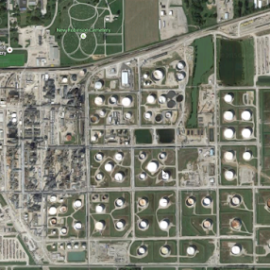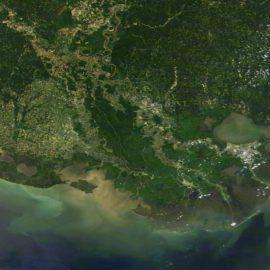
Hurricane Ida passed and the refineries went back into business, but without air monitors.
Oil refineries and petrochemical plants have been flaring at full blast in Louisiana’s “chemical corridor” along the Mississippi River since Hurricane Ida, and the 15 of the state Department of Environmental Quality‘s air monitoring stations are out of service. The department has set up mobile trailers containing equipment to sniff out chemicals in the air and take samples from the ground and water near two of the disabled monitoring stations: at the Shell Norco petrochemical complex in St. Charles Parish, where numerous flares have been pumping out a mix of black smoke and steam since Ida hit Sunday and near the Chalmette and Valero refineries and other petrochemical plants in St. Bernard Parish. The other monitoring stations that are down are at Carville, New Orleans City Park, Dutchtown, French Settlement, Garyville, along Interstate 610 in New Orleans, in the Irish Channel in New Orleans, Kenner, Madisonville, Marrero, Meraux, St. Rose and Thibodaux. “They are powered by electricity,” which is still down in most of those areas, agency spokesperson Greg Langley said Thursday.
nola.com
The plants, now they are back at work and back emitting pollution.
Flaring can result of a mix of issues at a particular plant, said Brian Johnston, administrator of air permits for the agency. “A flare is essentially a safety device,” he said. “It’s typically designed to burn off large volumes of hydrocarbon gases as a plant starts up or shuts down, or if there’s a malfunction or upsets. It’s designed to safely combust the gas.” Some of the plants have their on electric co-generation units that provide them with the electricity to continue operating even after a hurricane such Ida knocks out commercial power. Others are entirely dependent on the electric grid – and run into trouble when electricity is not available. “Why we’re seeing a lot of black smoke is because one of the primary methods to keep a flare from smoking is to apply steam to the flare tip,” Johnston said. That lets gases burn with less black smoke and also creates less particulate matter, itself a pollutant.
It is this blackness that is monitored. The less the better.
Under federal and state regulations, the flares are required to meet standards of opacity, or the amount of blackness seen in the flare release, Johnston said. In some cases, the standard is zero, while some plants are allowed an opacity level of no higher than 20 percent. That means plants producing black smoke after Ida are violating those regulations, But enforcement is likely to be minimal. During past storms, the state has agreed with company officials that the higher emissions were the result of an “act of God” such as a hurricane or other weather event. “The black smoke looks scary and it implies that combustion is not as efficient as it should be, but that’s not really the case,” Johnston said. “They may emit more particulate matter than a nonsmoking flare, but the impact on the flare’s ability to destroy hydrocarbons is minimal.
Should we be worried? Black smoke is bad and we are seeing more of it at the restart.
“There shouldn’t be any cause for alarm,” he said.
No cause for alarm when more violations are being reported?
Meanwhile, the agency fielded another 36 Ida-related reports of environmental issues on Wednesday, including including reports by Hilcorp Energy of incidents involving 11 of its oil and gas wells in a variety of coastal locations, most involving spills or evidence of sheens caused by oil releases. Witt O’Briens LLC, a company that responds to oil and gas incidents, reported that three unnamed facilities were knocked down by Ida at locations in state waters in the Gulf of Mexico. The Phillips 66 Alliance Refinery reported, “Refinery flooded; found heavy oil in floodwater.”
The Coast Guard National Response Center also receives calls. These may not be added to the tally of the state agencies involved.
Similar reports made to the U.S. Coast Guard’s National Response Center have not been added to the agency’s online public database, which has not been updated since the day Ida made landfall. Copies of the individual reports are available to the public only through a federal Freedom of Information Act request, to which the agency has 20 days to respond. The Department of Environmental Quality has begun “rapid needs assessments” in partnership with the State Police. Two-person teams had conducted 90 site visits as of Wednesday afternoon, with nine teams working Wednesday and 11 teams focusing on Terrebonne and Lafourche parishes on Thursday. The teams go to permitted facilities in a door-to-door sweep to look for spills or release of hazardous material, and also report to other state officials when they discover other concerns not directly related to their environmental assessments. Langley said no significant issues had been discovered during the visits through Wednesday afternoon.
These reports should be able to be viewed as they are posted online.
Individual reports on each site visited are eventually to be posted online in the department’s public database. The U.S. Environmental Protection Agency also has begun environmental assessments across the state. “EPA’s ASPECT aircraft – the agency’s airborne real-time chemical and radiological detection, infrared and photographic imagery platform – was activated today to support the state of Louisiana. ASPECT is generating data on a list of priority sites identified by the state of Louisiana,” said Maggie Sauerhage of EPA’s Office of Science Advisor Policy and Engagement. “As of Sept. 1, EPA had completed assessments for 24 of 25 Superfund sites on the National Priorities List in Louisiana and Mississippi with no documented releases or impacts to the environment,” she said. On Thursday, “EPA Region 6 & 7 mobile labs were deployed in response to a FEMA Mission Assignment for mobile drinking water lab support in Louisiana. Two EPA drinking water and wastewater subject matter experts were also deployed on September 1 to assist FEMA and Louisiana.”
Hurricanes cause damages as the Alliance refinery can attest but in their operation mode we need to have the sensors and then have citizens track the reports. Keep the reports of violation on the up and up.



